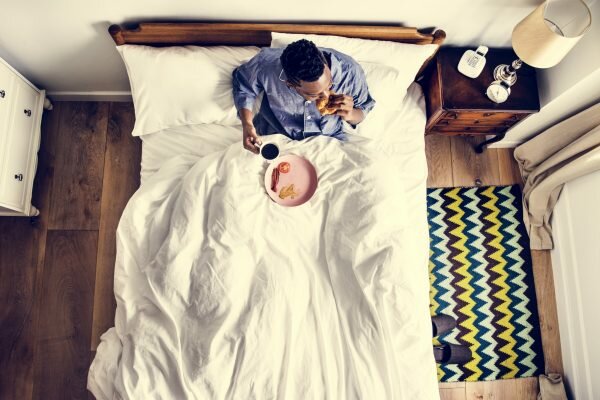How to Create a Yoga Studio in Your House According to Yogi, Jolene Cherry

Disruption is prevalent everywhere due to the current state of affairs, perturbing lifestyles across the board. As citizens and governments attempt to return to some state of normalcy, the fate of gyms and yoga studios alike remain uncertain. Even before the global crisis, carving out time in a hectic schedule for an exercise class or hour-long yoga session was stressful enough. But now, more than ever, it’s critical to set aside time for physical activity and meditation to preserve your well-being—all the more reason to invest in creating a yoga oasis in your lovely abode.
Yoga instructor, Jolene Cherry, has trained under teachers around the world, each with a unique personality and environment for practice. Her diverse international experience, coupled with her distinct style that she’s molded over the years, has sharpened her ability to find harmony and balance in any surroundings. For yoga practitioners wishing to achieve the same bliss and elevate their performance, she recommends adhering to the following guidelines to create an exceptional yoga sanctuary.
Intent
While it’s possible to cram a yoga class into a crowded living room and follow along to a YouTube video, it’s far from ideal. Naturally, not everyone has an excessive amount of spare space within their living quarters. Still, regardless of square footage, it’s possible to transform any area into a beautiful at-home yoga studio, as long as you design with intent.

Remember, this sacred place will serve as the anchor of your practice. A common rule of thumb to allocate an appropriate amount of room for stretching is at least 21 square feet per practitioner. This ground rule should provide you with ample room for the yoga mat, plus a little extra breathing room. However, beware of any adjacent furniture that may cause harm if you become unbalanced during a more advanced pose like a headstand.
As for discovering a suitable vibe, it should beget from your identity and interests. Yoga, after all, is a wonderful opportunity to nurture personal needs and rejuvenate energy levels.
Cost
The scope of the project’s budget must be determined on a personal basis, but regardless of income size, it’s an immensely helpful planning tool. A budget provides a bird’s eye view of the entire process and can help stretch each dollar further. Furthermore, if you dedicate substantial time to the planning phase and balancing costs, the remaining steps will be stress-free and fun.
Lighting
Different light sources each have a particular effect on the human subconscious. For example, human beings generally respond better to natural lighting versus fluorescent lights that are so common throughout work offices. As you sculpt your yoga haven, contemplate how you can integrate sunlight. Consider that most plants thrive in the sunshine; the same concept applies to humans and is an excellent source of Vitamin D, which is vital to immune health.
If natural light isn’t an option, or you prefer to practice in the evening once the sun has set, soft indoor lightbulbs may be the perfect solution. Complemented with soft cream shades, you’ll be able to harness warmth and tranquility. Consider dimming bulbs and mechanisms for an additional customized touch.
Essentials
If you’re already accustomed to home practice, you may already own the essentials. But, on the other hand, if you’ve relied on your local studio to supply the gear in the past, it’s time to purchase the core instruments.

First and foremost, acquire an environmentally friendly yoga mat. The color and feel should gel with your body since it’s the focal point of poses and meditation.
Accessories like a bolster, meditation, pillow, strap, and pair of yoga blocks can help improve posture and reduce strain on joints and muscles.
Decor
Maybe you’re redecorating the living room or starting with an empty room and blank walls; either way, it’s time to let the creative juices flow!
If decor and design have never been your “thing,” fret not. Sometimes practical and straightforward is best. Whatever route you choose, surround yourself with purpose. For example, house plants are low maintenance and help you relax. Several scientific studies suggest a significant correlation between wellness and spending time in nature.
Other useful items include relaxing water features, candles or essential oils diffuser, a Bluetooth speaker to play soothing music or ambient sounds, Buddha statues, tapestries to add color, etc. The list goes on. Lastly, have fun and enjoy yourself. After all, an at-home yoga studio is like having access to a restorative retreat anytime you want.
About Jolene Cherry: Jolene Cherry is a certified and experienced yoga instructor and personal trainer based in Portland, Oregon. She has always been interested in fitness, meditation, and nutrition and decided to help others reach their desired levels of physical fitness. Her international training and experience, ranging from Hawaii to Thailand, along with her nurturing one-on-one sessions have helped propel her to a prominent personal trainer and yoga instructor in the Pacific Northwest. She excels in a variety of yoga styles, especially Vinyasa Yoga, traditional Ashtanga Yoga, Power Yoga, as well as meditation-oriented Yin Yoga.














